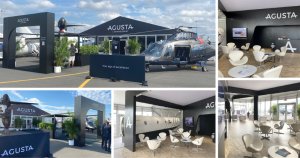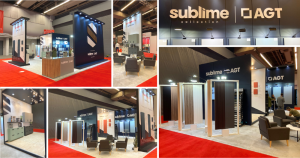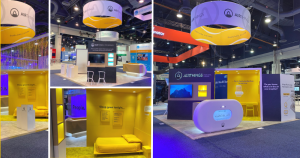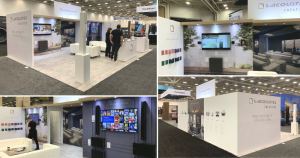The power of storytelling in trade show booth design
Trade shows can serve as pivotal platforms for businesses to make their mark in the industry. But companies typically face fierce competition during these events as they vie for the attention of attendees. Setting oneself apart in this dynamic environment can seem like a daunting task.
To truly shine, businesses must leverage various strategies, from eye-catching displays to interactive technologies and riveting presentations. Yet, amidst these tools, one stands out: storytelling.
“Storytelling is the social and cultural activity of sharing stories” and can be traced as far back as the Old Stone Age with cave art.
Storytelling has transcended traditional media and found its place at the heart of trade show booth design, offering a captivating way to engage, connect, and leave a lasting impression on visitors.
In this article, we will explore how you can use storytelling for your trade show booth design.
The narrative arc in trade show booths
At its essence, storytelling is about conveying a narrative, and this narrative approach can be applied to trade show booth design. Just as a well-crafted story has a beginning, middle, and end, a booth’s layout and design can guide attendees through a narrative arc that weaves your brand’s story into their event experience.
“The beginning”—How to capture attention and build curiosity
In the crowded and visually stimulating environment of a trade show, grabbing the attention of attendees is the first challenge. Start with an eye-catching display or feature that serves as the “hook” of your story. This could be a stunning visual element, an interactive technology display, or an intriguing prop that piques curiosity.
Photo totm exposition
Consider a visually striking backdrop that communicates the essence of your brand or product. This serves as the opening scene of your narrative, setting the stage for what’s to come.
“The middle”—How to unveil the narrative layers
As attendees explore your booth, it’s time to unveil narrative layers that will give depth and context to your brand’s story. This is where you connect the “why” behind your brand, products, or services, emphasizing the value they offer to the visitors.
Photo totm exposition
Use graphics, multimedia presentations, and live demonstrations to provide these layers of storytelling. Interactive touchscreens or displays can allow visitors to explore your brand’s journey, mission, and products at their own pace.
“The end”—How to leave a lasting impression
Every great story has a memorable ending; your booth’s narrative should be no different. Conclude your narrative with a noteworthy takeaway. This could be a call to action, a special offer, or a personalized experience reinforcing your booth’s message.
Think of it as the resolution of your story—where attendees leave your booth with a sense of fulfillment and a clear understanding of what your brand stands for.
Build an emotional connection by forging bonds through storytelling
Compelling storytelling goes beyond conveying information; it creates an emotional connection with your audience. Booth design should evoke emotions that resonate with your brand and message.
Photo totm exposition
Consider elements like color schemes, lighting, and even scents that trigger specific emotions and align with your narrative. For example, warm and inviting colors can convey a sense of comfort and trust, while dramatic lighting can evoke excitement or intrigue.
Engage the senses by creating a multisensory experience
Storytelling is not limited to words and visuals; it engages all the senses. In your booth design, consider how to stimulate attendees’ senses to immerse them in your narrative.
You can achieve this through:
- Visuals: Use captivating graphics, videos, and visuals that align with your story. These can be projected onto screens, printed on banners, or integrated into interactive displays.
- Audio: Consider background music or soundscapes that complement your narrative and create a sensory experience. Sound can evoke emotions and enhance the ambiance.
Photo totm exposition
- Touch: Incorporate tactile elements that encourage interaction. This could be touchscreens, product samples, or textured materials that convey your brand’s message through touch.
- Taste and smell: If relevant, offer tastings or scents that enhance your narrative. This is particularly effective for food-related or sensory-driven brands.
Interactive storytelling and user-generated content
Interactive storytelling is another interesting approach. Consider using virtual reality (VR) or augmented reality (AR) experiences that allow attendees to immerse themselves in your narrative. Through interactive apps or experiences, attendees can participate actively in your brand’s story.
Incorporating user-generated content (UGC) into your booth design can also be a powerful way to enhance your storytelling. Encourage attendees to share their experiences on social media with a unique event hashtag, then display these posts on screens within your booth in real time. UGC extends the reach of your booth’s narrative and creates a sense of community and participation.
In conclusion
Storytelling has become a powerful tool in trade show booth design, enabling businesses to connect with attendees on a deeper level. By crafting a compelling narrative arc, evoking emotions, engaging the senses, and incorporating interactive elements, trade show booths can leave a lasting impression and drive meaningful connections.
In the fast-paced world of trade shows, storytelling can guide visitors through the noise and into your brand’s unique narrative. When your booth becomes a story worth experiencing, attendees become willing protagonists in your brand’s unfolding tale.
If you want a one-of-a-kind booth, the teams at totm exposition are here for you!
Author : Véronique Colombani







